Cyber threats are evolving fast, with AI-powered attacks on the rise. In 2025, 87% of organizations reported facing AI-driven cyberattacks, and phishing emails generated by AI saw a 54% click-through rate compared to just 12% for human-written ones. For small and medium-sized businesses (SMEs), an average cyberattack now costs $1.6 million, yet many lack proper defenses. AI malware sandboxing tools are stepping in to help businesses detect and stop threats in real-time by analyzing behavior instead of relying on outdated signature-based methods.
Here are the top 7 AI malware sandboxing tools of 2025:
- Cuckoo Sandbox: Open-source, customizable, and integrates machine learning for malware detection with 95%-99% accuracy.
- VirusTotal: Cloud-based, uses AI to analyze code and detect threats missed by traditional tools. Free and premium plans available.
- CylancePROTECT: AI-driven endpoint protection that blocks threats before execution, effective for zero-day attacks.
- Falcon Sandbox by CrowdStrike: Hybrid analysis with AI-powered threat intelligence and anti-sandbox evasion capabilities.
- Sophos Sandstorm: Cloud-based, focuses on web and email protection with flexible subscription pricing.
- Joe Sandbox: Multi-platform malware analysis using AI for phishing detection and advanced behavioral analysis.
- Hybrid Analysis by CrowdStrike: Free cloud-based tool using AI to identify malicious domains/URLs and zero-day threats.
Quick Comparison
| Tool | Free Version | Deployment Options | Key Feature | Best For |
|---|---|---|---|---|
| Cuckoo Sandbox | Yes | On-premise | Open-source, customizable AI tools | Tech-savvy teams |
| VirusTotal | Yes | Cloud-based | Multi-engine scanning with AI | Quick threat analysis |
| CylancePROTECT | No | Cloud/On-premise | Predictive threat prevention | Proactive endpoint security |
| Falcon Sandbox | No | Cloud-based | Advanced hybrid analysis | Detailed threat intelligence |
| Sophos Sandstorm | No | Cloud-based | Web and email protection | Easy integration with Sophos tools |
| Joe Sandbox | Yes | Cloud/On-premise | AI for phishing and malware analysis | Versatile threat analysis |
| Hybrid Analysis | Yes | Cloud-based | AI-driven domain/URL detection | Budget-conscious organizations |
AI malware sandboxing tools are no longer optional for SMEs. They offer real-time threat detection and can save businesses from costly breaches. Choose a tool that fits your budget, deployment needs, and technical expertise.
Behavioural Analysis with Falcon X AI: Analyzing advanced malware strains in cloud environments.
1. Cuckoo Sandbox
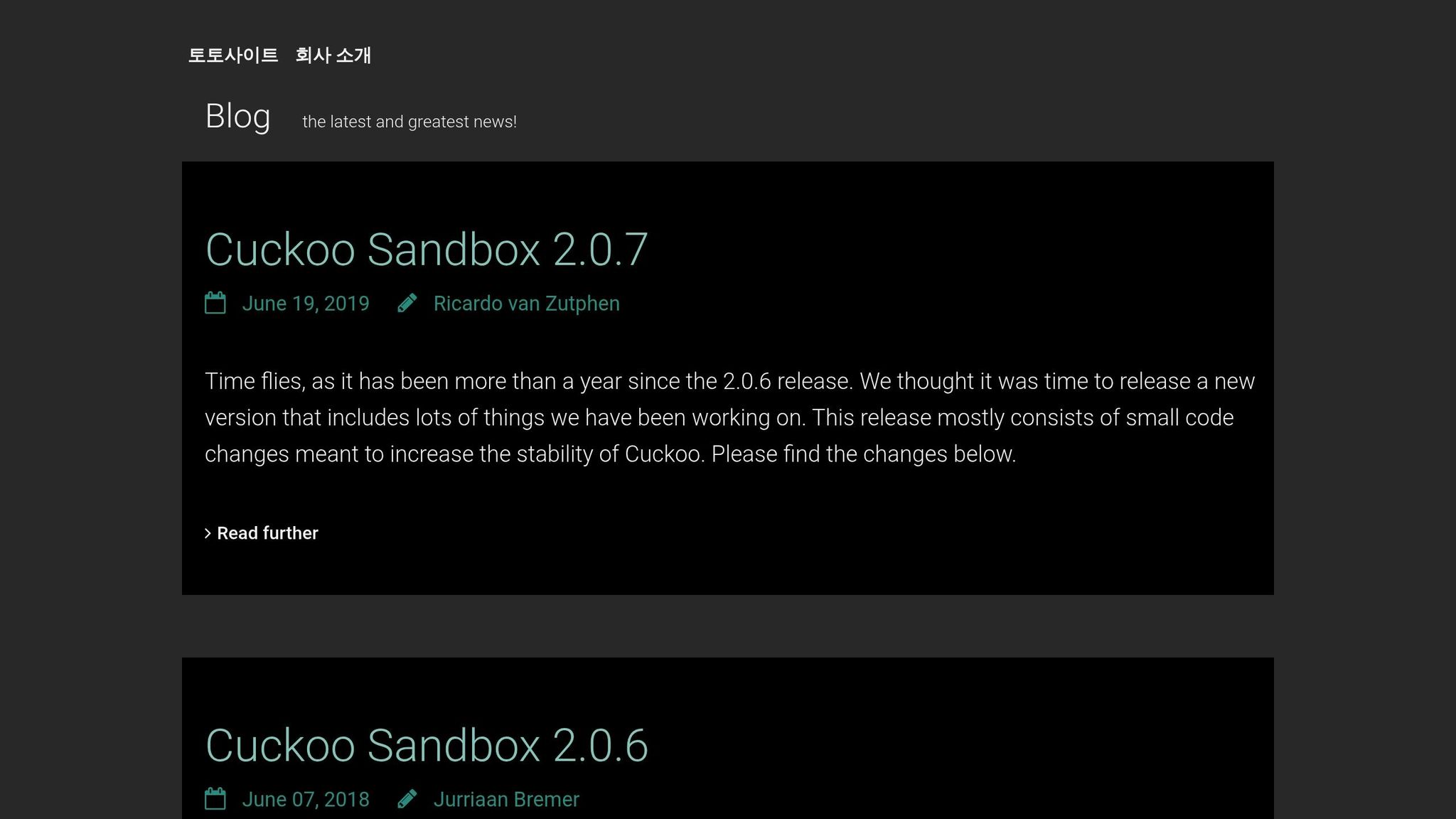
Cuckoo Sandbox is a dynamic open-source malware analysis platform that has stepped up its game with AI-powered threat detection. Initially created to analyze suspicious files and their behavior, it has evolved into a critical tool for small and medium-sized enterprises (SMEs) looking to strengthen their cybersecurity defenses. Its ability to support real-time threat detection makes it particularly valuable in combating the increasing complexity of cyberattacks.
"Cuckoo Sandbox is an open-source automated system for analyzing suspicious files, offering detailed insights into malware behavior." - Mindflow
AI and Machine Learning Capabilities
One of the standout features of Cuckoo Sandbox is its integration with artificial intelligence, which significantly boosts its malware detection accuracy. A key project, CuckooML, merges machine learning with the platform to analyze API call patterns from both safe and malicious software. These patterns are then used to train detection models. With the addition of deep learning techniques like Recurrent Neural Networks (RNNs), Cuckoo Sandbox achieves malware classification accuracies ranging from 95% to 99%.
The AI functionality works by converting the detailed reports generated by Cuckoo Sandbox into formats that machine learning algorithms can process. Both deep learning and traditional machine learning methods trained on Cuckoo-generated datasets consistently deliver over 90% accuracy. The CAPE (Community Advanced Platform Emulator) extension further enhances these capabilities by introducing features like automatic unpacking and a Python 3-based plug-in system for custom threat detectors. Together, these tools make Cuckoo Sandbox a reliable choice for real-time malware detection.
Real-time Analysis and Behavioral Detection
Cuckoo Sandbox specializes in behavioral analysis, running suspicious files in isolated virtual environments to observe their actions. This approach captures in-depth data on malware activity, such as process creation, file system alterations, network traffic, and registry changes. By focusing on behavior rather than static signatures, the platform can detect threats more effectively, even those that are previously unknown.
The analysis process involves monitoring and mapping observed behaviors to predefined malicious activity patterns. This provides security teams with actionable insights to respond to and neutralize threats efficiently.
| Analysis Technique | Purpose |
|---|---|
| API Call Analysis | Examines API calls to understand how malware interacts with the system |
| Network Traffic Analysis | Monitors network communications to detect malware's external activities |
| Registry Modification Analysis | Tracks changes in the registry to identify persistence mechanisms |
Deployment Options (Cloud, On-premise, Hybrid)
Cuckoo Sandbox is designed for on-premise deployment, giving SMEs complete control over their malware analysis environment. It supports multiple virtualization technologies, including VirtualBox, VMware, KVM, and XenServer, allowing businesses to integrate it seamlessly into their existing IT infrastructure. The platform is compatible with GNU/Linux, macOS, and Windows, making it flexible enough to suit various environments.
Although it doesn’t come with native cloud deployment options, SMEs with technical expertise can configure it on cloud platforms like AWS or Azure. By setting up virtual machines in the cloud, businesses can adapt Cuckoo Sandbox to their specific needs, whether they prefer on-premise control or cloud-based scalability.
Pricing and Scalability for SMEs
For SMEs operating on tight budgets, Cuckoo Sandbox offers a cost-effective solution. As an open-source platform, it eliminates licensing fees, allowing businesses to access enterprise-grade malware detection without breaking the bank. The main costs involve setting up the necessary infrastructure, maintaining it, and ensuring the team has the technical know-how to manage the system effectively.
The platform's scalability depends on the underlying infrastructure. SMEs can start small with a basic setup and gradually increase their capacity by adding more virtual machines or upgrading hardware as their security requirements grow. While it does require some technical expertise, the flexibility and cost savings make it a practical choice for SMEs looking to enhance their cybersecurity defenses.
2. VirusTotal
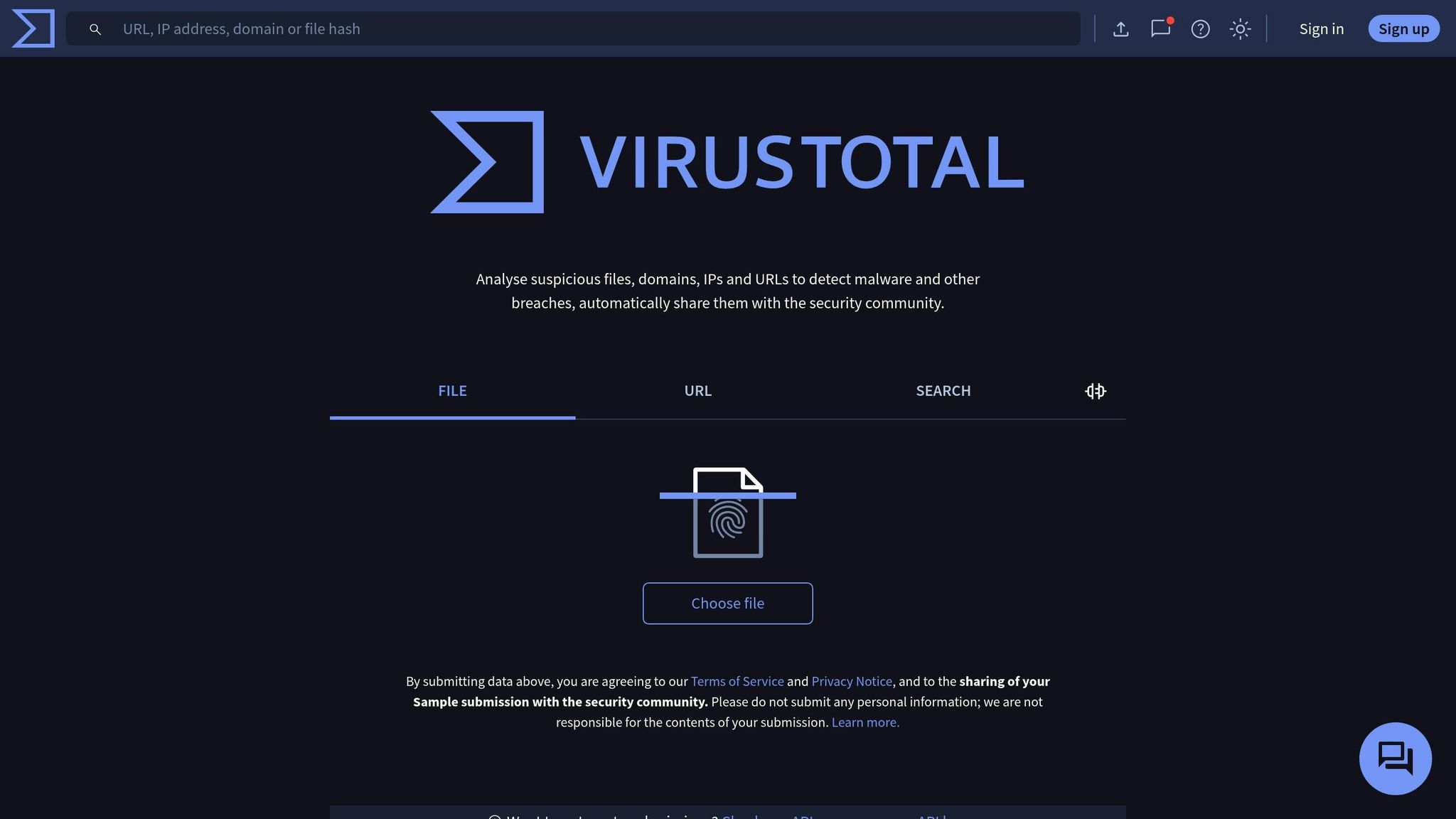
VirusTotal is a cloud-based malware analysis platform that processes an impressive 6 million analyses daily. With a massive dataset of over 50 billion files, 6 billion URLs, and 4 billion domains, it has become a go-to tool for small and medium-sized enterprises (SMEs). Below, we’ll explore how its AI features and deployment options make it indispensable for cybersecurity.
AI and Machine Learning Capabilities
VirusTotal takes threat detection to the next level with its Code Insight feature, powered by Google Cloud Security AI Workbench. This AI-driven tool translates code into plain language, making it easier for analysts of all experience levels to understand potential threats.
"For quite some time, artificial intelligence (AI) and machine learning (ML) have played a crucial role in anti-malware and cybersecurity, mainly focusing on classification tasks." – VirusTotal Blog
Using large language models (LLMs) trained on programming languages, VirusTotal can break down code into natural language summaries. This capability has proven highly effective in real-world scenarios. For example, Code Insight identified malware designed to steal user credentials that traditional antivirus tools missed. In another case, it correctly identified a file type and fixed a misclassified JavaScript tag.
The platform also employs YARA rules - custom patterns and signatures that help detect specific malware families or threat actor behaviors.
"The integration of LLMs into the arsenal of code analysis tools is a significant advancement that enables security professionals to gain valuable insights into the structure and behavior of potentially malicious code, improving threat detection and response efficiency." – VirusTotal Blog
Real-time Analysis and Behavioral Detection
VirusTotal doesn’t stop at AI; it also excels in real-time behavioral analysis. Its multi-engine threat detection scans files and URLs using over 70 antivirus engines and website scanners, providing detailed reports on flagged items. The platform’s Private Scanning feature allows users to analyze URLs and files in a secure, non-shareable mode. This includes dynamic analysis in sandboxes and compatibility with YARA, Sigma, and IDS rules. Analysts can even interact with URLs during sandbox detonation to study dynamic content in a controlled setting.
The platform monitors network communications, registry activity, and file processes by integrating with a mix of homegrown, open-source, and third-party sandboxes. Advanced options during sandbox detonation also allow analysts to simulate network conditions, offering deeper insights into threat behavior. One standout example of VirusTotal’s effectiveness occurred in May 2025, when Palo Alto Networks submitted a two-year-old file initially marked benign. After a rescan request, VirusTotal flagged it as an instance of Cobalt Strike.
Deployment Options (Cloud, On-premise, Hybrid)
VirusTotal’s cloud-first approach is particularly appealing for SMEs. As a cloud-based service, it eliminates the need for complex on-premise infrastructure. This setup ensures automatic updates to its threat intelligence database, access to Google’s computational resources, and effortless scalability without requiring additional hardware. The platform also integrates seamlessly with existing security workflows through its comprehensive API options, which can be accessed via web interfaces, direct API integrations, or third-party tools.
Pricing and Scalability for SMEs
VirusTotal offers tiered pricing to cater to a range of users. Its free version provides basic features and is ideal for small businesses or individual users. However, the free Public API has limitations - 500 requests per day at a rate of 4 requests per minute - and cannot be used for commercial purposes.
For SMEs with more advanced needs, VirusTotal offers premium plans with custom pricing. The median cost for these plans is approximately $20,592 per year, with typical annual costs ranging from $11,088 to $37,281. The Private API allows businesses to customize request rates and daily quotas based on their requirements.
| Plan Type | Daily Requests | Rate Limit | Commercial Use | Typical Annual Cost |
|---|---|---|---|---|
| Free Public API | 500 | 4 per minute | Not allowed | $0 |
| Private API | Customizable | Customizable | Allowed | $11,088–$37,281 |
| Enterprise | Unlimited | Customizable | Full commercial | Custom quote |
VirusTotal has earned high user ratings, scoring 4.4 out of 5 on PeerSpot and 4.9 out of 5 on Capterra. While some users manage costs by utilizing multiple free licenses, others find the enterprise pricing relatively steep. Since its acquisition by Google, all purchases must go through Google directly. Resellers need to work with TD Synnex as a distributor to access pricing details.
3. CylancePROTECT
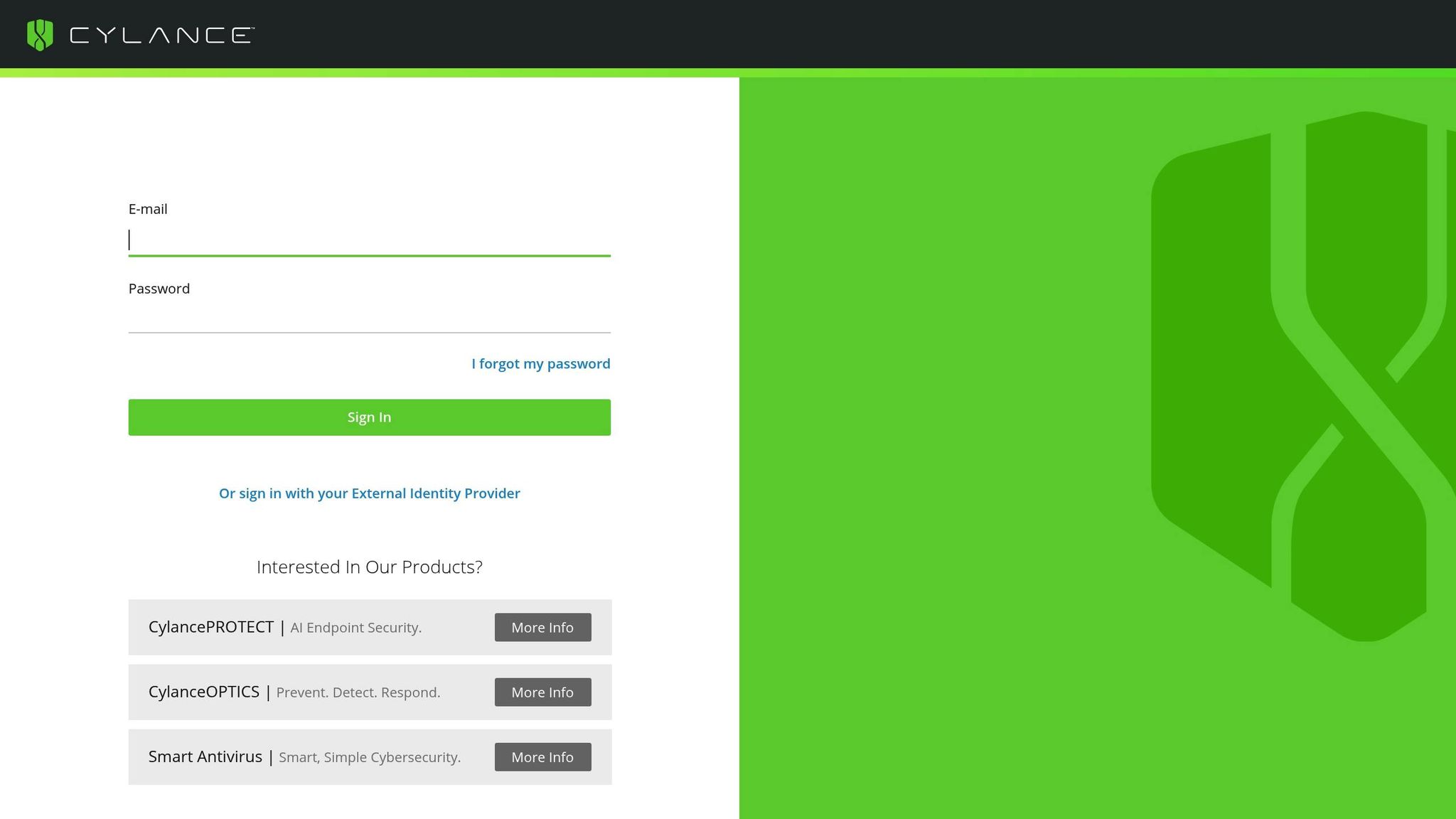
CylancePROTECT, developed by BlackBerry Cylance, takes a bold step in endpoint security by relying on AI-driven intelligence rather than traditional signature-based methods. Its proactive approach to threat prevention is particularly appealing to small and medium-sized enterprises (SMEs) looking for strong cybersecurity solutions.
AI and Machine Learning Capabilities
CylancePROTECT is one of the pioneers in offering a fully AI-powered antivirus engine. Instead of relying on signatures, it uses advanced algorithms to detect threats. By analyzing file characteristics mathematically, it classifies files as either benign or malicious, blocking threats before they can execute. This makes it highly effective against zero-day attacks.
"Cylance stands out for pioneering the delivery of a complete AI-driven antivirus engine that relies primarily, if not solely, on AI and machine learning for threat identification. Remarkably, it identifies over 99.7% of global threats." – Hadar Eshel, Co-Founder and CEO at Cloudway
What’s more, this AI-driven system works efficiently even in environments with limited internet access, making it a practical choice for businesses operating in areas with intermittent connectivity.
Real-time Analysis and Behavioral Detection
CylancePROTECT doesn’t stop at file analysis. It also monitors behavioral patterns in real time, using machine learning models that react in milliseconds to detect and block malware. A lightweight agent integrates effortlessly with existing software management systems or a cloud console, applying advanced mathematical models directly on the host device. This eliminates the need for signature databases.
The solution also excels in behavior-based detection. It keeps an eye on program actions, such as script-based attacks (like PowerShell and macros) and unusual memory usage, to identify potential exploits before they cause harm.
Deployment Options (Cloud, On-premise, Hybrid)
CylancePROTECT offers flexible deployment options that fit a wide range of business needs. Whether your organization runs on physical machines, virtual environments, or a mix of both, this solution has you covered. It supports Windows, macOS, and Linux, ensuring comprehensive protection across different operating systems.
Pricing and Scalability for SMEs
While specific pricing details aren’t publicly available, CylancePROTECT’s lightweight agent minimizes bandwidth and resource usage, which can help reduce operational costs. With a threat detection rate exceeding 99.7%, it delivers strong value by reducing the need for extra security tools or frequent manual oversight. Its scalability is another major plus - SMEs can start small and expand as needed, thanks to its compatibility with virtualized and cross-platform environments. This makes it an excellent choice for businesses with limited resources but ambitious security needs.
4. Falcon Sandbox by CrowdStrike
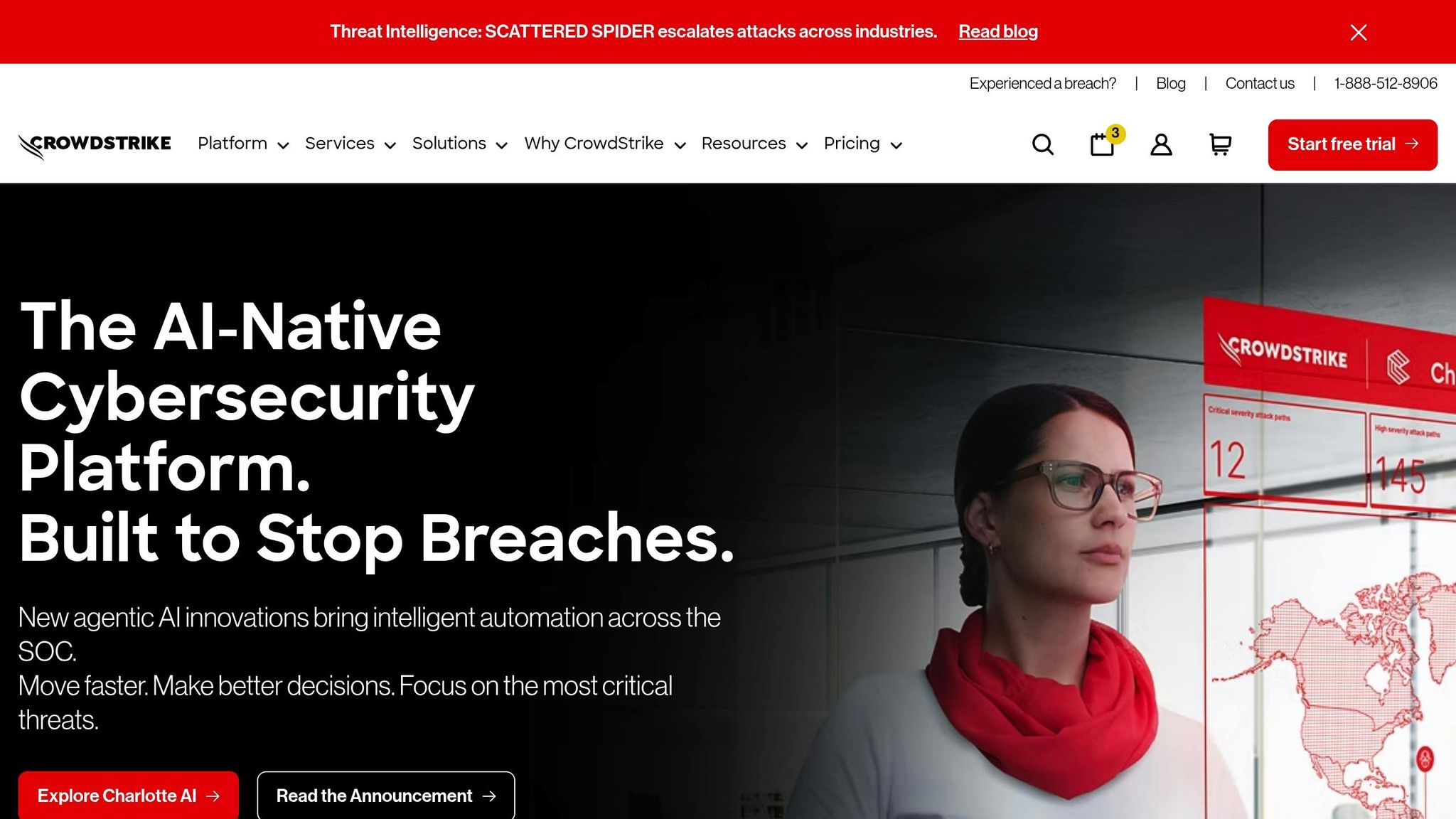
Falcon Sandbox uses hybrid analysis to tackle advanced threats effectively. Built with a cloud-first approach, it provides powerful malware analysis without depending on traditional signature-based methods. Let’s dive into its AI features and real-time detection capabilities.
AI and Machine Learning Capabilities
Falcon Sandbox employs machine learning models refined with top-tier threat intelligence, delivering precise malware detection. These models focus on analyzing behavior, which helps cut down on false positives.
The platform’s hybrid analysis technology is particularly adept at identifying unknown threats, including zero-day exploits. This method captures more indicators of compromise (IOCs) compared to other sandbox solutions, giving security teams deeper insights into potential threats.
Its AI-driven tools also enhance threat intelligence by identifying file campaign affiliations, malware families, and even attributing threats to specific actors.
Real-time Analysis and Behavioral Detection
Falcon Sandbox supports over 40 file types - ranging from executables and documents to images, scripts, and archives - across Windows, Linux, and Android platforms. Designed for high-volume needs, it can process up to 25,000 files per month through automation.
Modern malware often tries to evade detection by recognizing when it’s being analyzed in a sandbox environment. Falcon Sandbox counters this with anti-sandbox detection technology, ensuring malware reveals its true behavior during analysis.
The platform also integrates seamlessly with other tools via a REST API and pre-built connectors, simplifying indicator sharing.
Deployment Options (Cloud, On-premise, Hybrid)
Falcon Sandbox offers flexibility with three deployment models tailored to different business needs:
- Public Cloud: A free, community-oriented option for basic testing.
- Private Cloud: A subscription-based service where all submission data is kept private. It’s ideal for businesses seeking cloud convenience while maintaining data confidentiality.
- On-Premise (Standalone): This option provides maximum control, allowing businesses to customize the sandbox environment to match their internal systems. While it requires technical expertise during setup, it offers unlimited file submissions, making it a strong choice for organizations with advanced technical resources.
Pricing and Scalability for SMEs
Falcon Sandbox follows a subscription-based licensing model based on submission allowances, making costs predictable and easy to scale. For small and medium-sized enterprises (SMEs), the Private Cloud option strikes a balance, offering more advanced features than the free Public Cloud while avoiding the complexity of on-premise deployment.
Its ability to automate the analysis of thousands of files monthly makes it a cost-effective choice. SMEs can start with the Private Cloud and transition to an on-premise setup as their needs evolve.
For organizations interested in contributing to better threat detection, CrowdStrike offers an opt-in program. Through this program, customers can share detected files to help refine the platform’s machine learning models with real-world data, enhancing detection accuracy over time.
sbb-itb-bec6a7e
5. Sophos Sandstorm
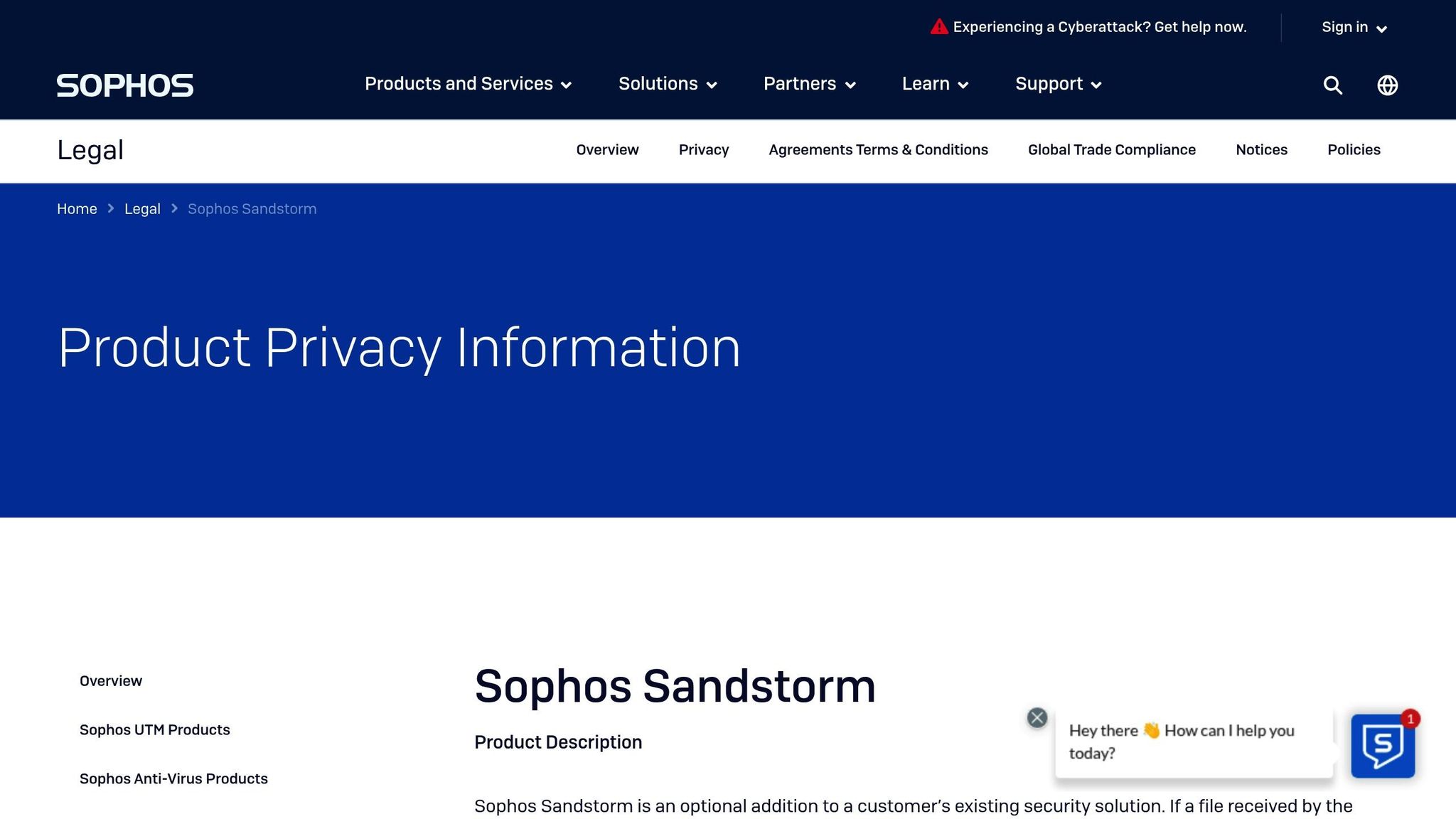
Sophos Sandstorm is a cloud-focused solution designed to strengthen web and email protection. It targets businesses looking for effective defenses against malware, especially those already using Sophos products.
Real-time Analysis and Behavioral Detection
Sophos Sandstorm boosts the capabilities of Web Protection and Email Protection, offering strong defenses against malware. When a suspicious file is flagged, the system runs it in a secure, isolated environment to uncover any hidden threats.
Easy Cloud-based Deployment
As a fully cloud-based service, Sophos Sandstorm eliminates the need for complicated hardware installations. Activating policies is straightforward, reducing both setup time and ongoing maintenance costs. It integrates seamlessly into existing workflows, making it accessible for organizations of all sizes.
Flexible Pricing and Options for SMEs
Sophos Sandstorm uses a subscription-based pricing model, with costs determined by the number of cores and RAM allocated to virtual appliances. This tiered approach is ideal for small and medium-sized enterprises (SMEs), offering flexibility to meet various budgets and requirements:
| Configuration | 1 Year | 2 Years | 3 Years |
|---|---|---|---|
| Up to 1 Core & 2GB RAM | ~$184.80 | ~$369.60 | ~$554.40 |
| Up to 2 Cores & 4GB RAM | ~$445.80 | ~$891.60 | ~$1,337.40 |
| Up to 4 Cores & 6GB RAM | ~$856.20 | ~$1,712.40 | ~$2,568.60 |
| Up to 6 Cores & 8GB RAM | ~$1,434.00 | ~$2,868.00 | ~$4,302.00 |
SMEs can also bundle Sandstorm with TotalProtect Plus or EnterpriseProtect Plus, which include additional security tools and centralized management through the Sophos dashboard.
Thanks to its cloud-based design, Sophos Sandstorm is well-suited for SMEs seeking a simple setup without compromising performance. Businesses can start with smaller configurations and scale up as their needs evolve, making it a budget-friendly option for growing security demands. This combination of scalability and affordability positions Sophos Sandstorm as a strong choice in the realm of AI-powered sandboxing solutions.
6. Joe Sandbox
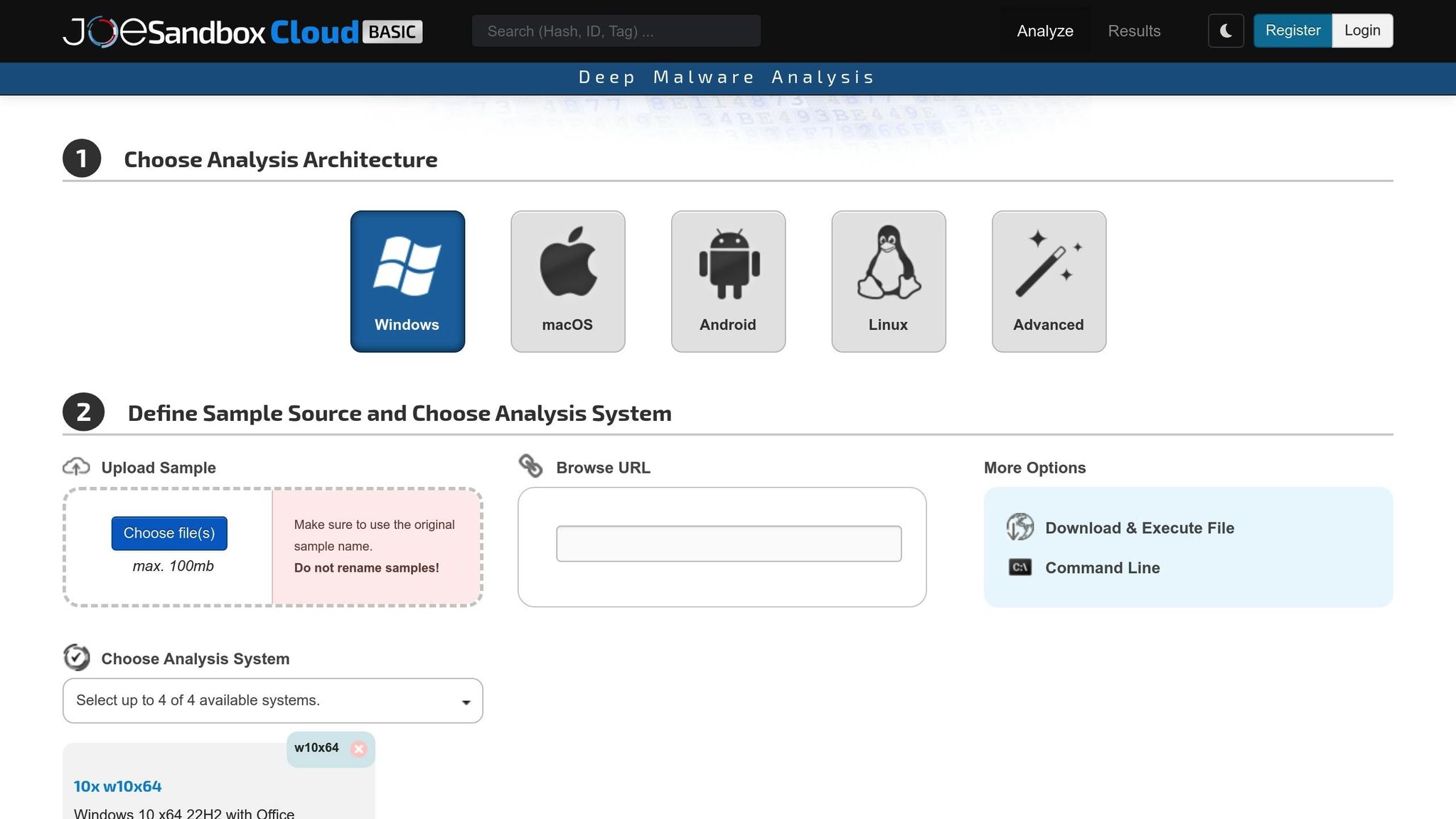
Joe Sandbox is a malware analysis platform that blends traditional sandboxing techniques with advanced AI capabilities. It’s particularly useful for organizations managing diverse IT setups, as it delivers in-depth threat analysis across multiple operating systems.
AI and Machine Learning Capabilities
Joe Sandbox AI leverages Generative AI models to identify phishing attempts and malicious landing pages. Using dynamic analysis, it evaluates email content, URLs, and embedded code through multiple AI models. It dives deep into inputs like JavaScript, screenshots, DOM trees, Office documents, PDFs, and OCR data. Additionally, it employs reasoning models to analyze email context, uncover phishing schemes, Business Email Compromise (BEC), and other social engineering tactics. These models also generate summaries that emphasize key behavioral patterns and threat indicators, significantly boosting real-time threat detection.
Real-time Analysis and Behavioral Detection
The platform takes its threat detection capabilities further with a fine-tuned language model designed to navigate phishing websites, bypass CAPTCHAs, and fill out forms, exposing sophisticated threats. It can also detect malicious SVG files and validate suspicious PE Authenticode signatures using advanced model insights. According to testing, Joe Sandbox AI consistently outperforms traditional tools in identifying threats.
Deployment Options
Joe Sandbox offers flexible deployment setups to suit various organizational needs. Businesses can choose between cloud-based and on-premise solutions. With Joe Sandbox Cloud, users can upload files and URLs for analysis via a web interface. For organizations requiring more control, on-premise solutions like Joe Sandbox Ultimate or Joe Sandbox Desktop are available. The cloud service supports threat analysis across Windows, Android, macOS, and Linux environments.
Pricing and Scalability for SMEs
Joe Sandbox uses a tiered pricing structure to cater to businesses of different sizes. The Joe Sandbox Cloud Basic plan is free, making it ideal for initial evaluations or minimal-scale needs, though it comes with limitations. For more advanced features, Joe Sandbox Cloud Light costs $5,000 per user annually. For enterprises with greater demands, Cloud Pro and Enterprise plans are available through custom quotes. While the Basic tier shares samples and results publicly and offers limited API access, higher tiers provide private analyses and API integrations that work with SOAR, SIEM, and EDR systems. This pricing structure allows SMEs to address evolving cyber threats without requiring a large upfront investment.
7. Hybrid Analysis by CrowdStrike
Hybrid Analysis by CrowdStrike, also known as CrowdStrike Falcon Sandbox v2, combines static and dynamic analysis with advanced AI to tackle threats that might slip past conventional detection systems. By blending traditional sandboxing methods with AI-driven insights, it delivers a robust solution for identifying and addressing potential cybersecurity risks.
AI and Machine Learning Capabilities
At the heart of CrowdStrike’s platform is its AI-powered threat detection system. This system uses a neural network classifier specifically designed to identify malicious domains and URLs. What sets it apart is its ability to learn from character- and sub-token-level patterns, enabling it to spot both familiar and entirely new threats.
"CrowdStrike AI uses a machine learning model for identifying malicious domains/URLs. The model learns representations for characters, tokens, and sub-tokens (i.e., embeddings) and uses them for building a Neural Network classifier. Learning these embeddings, especially at character and sub-token levels, enables the model to perform well on previously unseen tokens (e.g., unseen domains and URL parameters) and predict malicious or suspicious behavior."
This character-level learning gives the model an edge in detecting zero-day exploits and unknown malware. It not only confidently flags known threats but also predicts the behavior of previously unseen domains and URLs with impressive accuracy.
In March 2023, CrowdStrike introduced a new feature in its sample detonation reports. This enhancement added a category within the CrowdStrike AI section, displaying data on URLs and domains extracted from analyzed samples. URLs are now visually labeled as Malicious (red) or Suspicious (orange), making threat identification more intuitive.
Real-time Analysis and Behavioral Detection
The platform’s hybrid analysis approach combines static and dynamic techniques to uncover malicious code designed to evade traditional detection. This method identifies more Indicators of Compromise (IOCs) than many competing sandbox tools, especially when dealing with unknown or zero-day threats.
Falcon Sandbox provides a detailed overview of file, network, and memory activity. By integrating static memory analysis, the platform excels at detecting sophisticated threats. Additionally, CrowdStrike Falcon MalQuery further strengthens its capabilities by searching across a database of over 1.3 billion IOCs, offering an extensive repository for real-time threat intelligence.
Deployment Options
Hybrid Analysis operates as a cloud-based cybersecurity platform, catering to the needs of small and medium-sized enterprises (SMEs). It integrates malware protection, threat intelligence, and incident response services, all managed through a centralized control system. This centralized approach simplifies management across complex IT environments, making it an excellent choice for organizations with diverse infrastructures.
The cloud-based model eliminates the hassle of on-premise hardware maintenance while providing scalable processing power for malware analysis. This enables SMEs to access enterprise-level threat detection without the need for extensive infrastructure investments.
Pricing and Scalability for SMEs
While exact pricing details for Hybrid Analysis aren’t publicly available, CrowdStrike Falcon’s cloud model typically offers flexible pricing options to suit businesses of various sizes. Its ability to handle high-volume automated file analysis makes it particularly appealing for growing organizations.
The platform’s centralized cloud deployment minimizes IT overhead for SMEs by automating updates, maintenance, and scaling. This allows smaller businesses to maintain strong cybersecurity defenses without diverting resources from their core operations, ensuring protection against even the most advanced threats.
Feature and Price Comparison
Building on the detailed tool overviews above, this section breaks down how each option aligns with the needs of small and medium-sized enterprises (SMEs). Understanding the features and pricing of these AI malware sandboxing tools is critical for making an informed choice.
Open-Source vs. Commercial Solutions
If you're looking for a budget-friendly option, Cuckoo Sandbox is completely free and open-source. However, this affordability comes with the challenge of needing substantial technical expertise for setup and maintenance. For SMEs with limited IT resources, the initial configuration might feel daunting. But for businesses with skilled technical teams, Cuckoo's flexibility allows for extensive customization to meet specific needs.
On the commercial side, pricing varies significantly. For example, Joe Sandbox offers a free basic cloud tier, with professional plans starting at $4,999 per year. Meanwhile, Hybrid Analysis by CrowdStrike is entirely free to use, making it a compelling option for budget-conscious organizations.
Deployment Flexibility for SMEs
Modern sandboxing tools cater to diverse deployment needs. Cloud-based solutions like VirusTotal, Hybrid Analysis, and Sophos Sandstorm provide scalable processing power without requiring on-premise hardware maintenance. On the other hand, tools like CylancePROTECT and Falcon Sandbox offer flexible configurations to suit various IT environments. Here's a quick comparison of features to help you decide:
| Tool | Starting Price | Deployment Options | Key AI Features | Best For |
|---|---|---|---|---|
| Cuckoo Sandbox | Free | On-premise | Modular, customizable | Technical teams with development resources |
| VirusTotal | Free tier available | Cloud-based | Multi-engine scanning | Quick threat verification |
| CylancePROTECT | Contact for quote | Cloud/On-premise | Predictive threat prevention | Proactive endpoint protection |
| Falcon Sandbox | Contact for quote | Cloud-based | Advanced threat detection | Comprehensive threat intelligence |
| Sophos Sandstorm | Contact for quote | Cloud-based | Real-time scanning | Integrated endpoint security |
| Joe Sandbox | Free basic / $4,999/year pro | Cloud/On-premise | Cross-platform analysis | Versatile malware analysis |
| Hybrid Analysis | Free | Cloud-based | AI-driven threat detection | Budget-conscious organizations |
User Experience and Ratings
User reviews provide valuable insight into how these tools perform in real-world scenarios. For instance, VirusTotal boasts a 4.7/5 star rating, with users appreciating its simplicity and functionality. Similarly, Hybrid Analysis holds a solid 4.4/5 star rating, reflecting its reliability as a free tool.
Investing in robust sandboxing tools can save SMEs from costly cyberattacks. With the average cost of a mobile-related data breach for small businesses reaching $65,000, these tools are a wise investment. Considering that 82% of ransomware attacks target companies with fewer than 1,000 employees, prioritizing effective security measures is no longer optional.
Scalability Considerations
For SMEs planning for growth, scalability is a key factor. Cloud-based solutions are particularly appealing, as they allow businesses to expand their analysis capabilities without the need for additional hardware. The global network sandboxing tools market, valued at $124.5 million in 2025, is projected to grow to $324.2 million by 2033. This growth reflects ongoing advancements and the increasing importance of these tools.
Features like automated threat intelligence and multi-file support can significantly reduce manual workloads, a critical advantage for SMEs with limited resources. Seamless integration with existing security systems can further lower operational costs and improve efficiency. These capabilities ensure that businesses can select a tool that not only addresses their current needs but also adapts as they grow.
Conclusion
Choosing the right AI-powered malware sandboxing tool has become a critical step for small and medium-sized businesses (SMBs) in today's cyber threat landscape. Cyberattacks are hitting SMBs harder than ever, with the financial impact of a single breach often proving catastrophic. For many, the stakes couldn't be higher.
What sets AI-driven sandboxing tools apart is their ability to offer advanced protection without the need for large IT teams or hefty budgets. Unlike traditional security solutions built for enterprises, these tools bring predictive analytics and ongoing security assessments to the table. This makes it possible for SMBs to access enterprise-level defense tailored to their specific needs, whether they're working with limited resources or a smaller technical team.
There’s a wide range of options available - from free, open-source tools to full-scale commercial solutions. Whether you prioritize scalability with a cloud-based system or prefer the control of an on-premise setup, the key is finding a tool that aligns with your team’s expertise and your security requirements. Starting with solutions that support automated threat intelligence and multiple file types can be a smart move, allowing you to scale your approach as your business grows.
AI-powered tools are a game-changer for SMBs navigating the complex world of cybersecurity. Platforms like AI for Businesses make the process even easier by offering curated collections of AI solutions designed specifically for smaller enterprises. These resources help businesses find effective, easy-to-implement tools that provide strong protection without adding unnecessary complexity.
Investing in AI-powered malware sandboxing is no longer just a good idea - it’s essential. With 87% of organizations globally facing AI-driven attacks in the past year, and AI-crafted phishing emails achieving a 54% click-through rate compared to just 12% for human-written ones, the threats are evolving rapidly. Your sandboxing tool needs to be as smart and adaptive as the attacks it’s designed to block.
Finally, avoid the trap of overconfidence. Select a solution that fits your current needs and budget, and use it consistently. The cost of prevention is always far less than the cost of recovering from a breach.
FAQs
What makes AI malware sandboxing tools different from traditional antivirus methods?
AI malware sandboxing tools bring a fresh approach to threat detection by leveraging real-time behavioral analysis and machine learning. Unlike traditional antivirus software, which depends on recognizing known virus signatures, these tools are designed to tackle the ever-changing nature of modern threats. For instance, AI-powered malware that can modify itself to evade detection often slips past signature-based methods.
What sets AI-driven tools apart is their ability to spot unknown threats. They achieve this by analyzing patterns and detecting unusual behavior, making them highly effective against advanced threats like fileless malware or polymorphic attacks - types of cyberattacks that frequently outsmart older methods. As we move further into 2025 and cyber threats continue to evolve, these AI sandboxing tools offer businesses a smarter and more responsive way to stay protected.
What should small and medium-sized businesses look for in an AI malware sandboxing tool?
When choosing an AI malware sandboxing tool, small and medium-sized businesses should keep a few essential factors in mind to strengthen their cybersecurity. First, security and isolation are non-negotiable. The sandbox must function independently from your primary network, ensuring any potential threats are contained without risking broader exposure.
Next, ease of use plays a big role. The tool should be intuitive and align with your business's needs, even if you don’t have a dedicated IT team or extensive technical expertise. A user-friendly interface can save time and reduce the learning curve.
It’s also crucial to assess the tool’s ability to tackle advanced threats, especially those designed to bypass detection. Features like simulating user behavior and testing in diverse system setups can provide deeper insights into potential risks.
Finally, don’t overlook cost and scalability. Look for a solution that fits your current budget but can also grow alongside your business. Balancing these priorities will help safeguard your operations without overextending your resources.
How do AI malware sandboxing tools detect and stop zero-day threats?
AI malware sandboxing tools excel at identifying and halting zero-day threats by leveraging sophisticated algorithms to evaluate unusual behaviors, code structures, and irregularities in real time. Unlike older methods that depend on pre-identified signatures, these tools take a proactive approach, spotting and neutralizing unfamiliar threats before they can cause damage.
They do this using methods like behavioral analysis, where a file or program's actions are monitored in a controlled setting, and dynamic threat response, which adjusts to evolving attack strategies. These capabilities make them an effective defense against the constantly changing landscape of cybersecurity risks.


